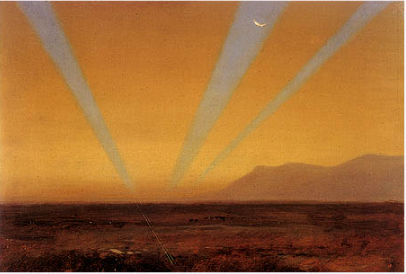Frederic Church Painting
The Enigmatic Frederic Church Painting: Unraveling the Mystery
Frederic Edwin Church, the renowned American landscape painter, has left an indelible mark on the art world with his breathtaking works. One particular painting has sparked curiosity and intrigue among art historians and enthusiasts alike. This small oil sketch, once believed to be a study for his famous painting "Aurora Borealis," now stands as a captivating enigma. Let us delve into the details of this masterpiece and attempt to unravel its mysteries.
The painting portrays a mesmerizing scene of crepuscular rays, also known as cloud shadows, emanating from a sun just below the horizon. The amber-tan rays illuminate the air, while the shadowed areas reveal a glimpse of the blue sky and a delicate crescent moon. Initially assumed to be a depiction of the Northern Lights, the artwork is now attributed to a sunset near Church's residence at Olana in the Hudson Valley, with the majestic Catskill Mountains gracing the right side of the canvas.
However, an intriguing puzzle emerges when we scrutinize the presence of the crescent moon. In the Northern hemisphere outside of the tropics, a waxing crescent moon never appears to the right of the sunset point. This discrepancy raises questions about Church's meticulous attention to detail. Known for his accurate portrayals of nature, it is perplexing to consider that he may have made an error.
There are several plausible explanations for this celestial anomaly within the painting. One possibility is that the sketch depicts a sunrise looking eastwards in the Hudson Valley. Alternatively, it could represent a sunset witnessed by Church during his travels in exotic locales such as Ecuador or Jamaica. The ambiguity surrounding the exact time and location only adds to the mystique of this artwork.
To fully appreciate the significance of this painting and Church's artistry, it is essential to understand the phenomenon of crepuscular rays. These ethereal rays, also referred to as "God rays," occur when sunlight passes through gaps in clouds or objects, casting stunning rays of light across the sky. The interplay of light and shadow creates a captivating spectacle that Church masterfully captured in his work.
Intriguingly, Church's exploration of atmospheric optics extended beyond this particular painting. Throughout his career, he demonstrated a keen interest in capturing the effects of light and atmosphere on the natural landscape. His meticulous attention to detail and ability to convey the subtleties of light and shadow set him apart as a true master of his craft.
As we contemplate the enigma of the Frederic Church painting, we are reminded of the complexities and intricacies of artistic interpretation. Art has the power to transport us to different times and places, evoking emotions and challenging our understanding of the world. Church's ability to create such captivating scenes invites us to ponder the mysteries of nature and our place within it.
In conclusion, the Frederic Church painting continues to captivate and confound art enthusiasts with its depiction of crepuscular rays and a mysterious crescent moon. Despite the discrepancy between the moon's position and the sunset point, this artwork remains a testament to Church's artistic genius and his ability to evoke a sense of wonder through his brushstrokes. Whether it portrays a sunrise in the Hudson Valley or a sunset witnessed during Church's travels, this painting invites us to appreciate the beauty of atmospheric optics and the enigmatic nature of art itself.

This small oil sketch by the great American landscape painter Frederic Edwin Church (1826 - 1900) clearly depicts crepuscular rays or cloud shadows streaming upwards from a sun just below the horizon. Amber-tan rays light the air. Where it is shadowed by clouds, blue sky and a thin crescent moon are revealed.
The painting was until recently thought by art historians to be a study for his painting Aurora Borealis! It is now claimed to be of a sunset near Church's home at Olana in the Hudson Valley looking westwards with the Catskill Mountains on the right.
There is, however, a problem - the crescent moon. A waxing crescent moon never appears to the right of the sunset point outside of the tropics in the Northern hemisphere. The rays cannot be anti-crepuscular because crescent moons do not appear opposite the sun. Church's portrayals of nature were usually so accurate that it is difficult to believe that he got it wrong. The sketch could be of a sunrise looking eastwards in the Hudson Valley, alternatively it could be a sunset seen by Church during his travels in Ecuador and Jamaica.
Note: this article has been automatically converted from the old site and may not appear as intended. You can find the original article here.
Reference Atmospheric Optics
If you use any of the definitions, information, or data presented on Atmospheric Optics, please copy the link or reference below to properly credit us as the reference source. Thank you!
-
<a href="https://atoptics.co.uk/blog/frederic-church-painting/">Frederic Church Painting</a>
-
"Frederic Church Painting". Atmospheric Optics. Accessed on April 24, 2024. https://atoptics.co.uk/blog/frederic-church-painting/.
-
"Frederic Church Painting". Atmospheric Optics, https://atoptics.co.uk/blog/frederic-church-painting/. Accessed 24 April, 2024
-
Frederic Church Painting. Atmospheric Optics. Retrieved from https://atoptics.co.uk/blog/frederic-church-painting/.